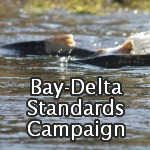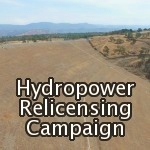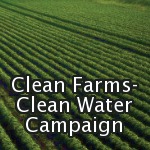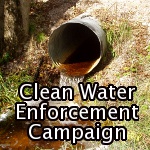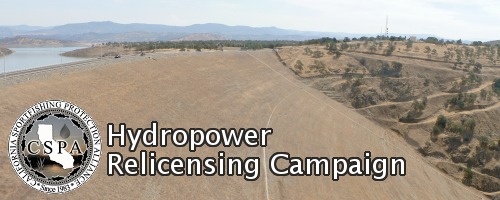Document and Comments Library
Blogs and Background
Hydroelectric Projects and Our Fisheries: An Overview
Every hydroelectric project in the United States is regulated by the Federal Energy Regulatory Commission (FERC). Each project whose capacity is greater than 5 Megawatts is licensed by FERC for a period of 30 to 50 years. Prior to the expiration of its license, every project operator must conduct a process called relicensing.
Thousands of miles of rivers and streams in California are affected by hydro projects: they are dammed, diverted, used for water conveyance, and used to absorb the outflow from power plants.
CSPA has long been active in hydro relicensing in order to improve fishing opportunities and fishery resources, many of which underwent serious declines over the past fifty or more years. In all too many previous licenses, conditions were created to protect power generation above all, and the fisheries and the rivers suffered terribly. Salmon and steelhead were cut off from upper watersheds, and were left to cook in low summer flows downstream of dams. Trout fisheries often survived more by luck than by plan, and many of these as well were badly degraded.
What Do We Want From Relicensing?
The simple answer is more water for fish.
We almost always ask that more of the water that was taken out of rivers and streams to operate generators be put back in the rivers and streams.
We also want high flows at times of year when they naturally occur. This moves gravel and keeps it in good condition for spawning fish.
We could sum up by saying that we want streamflows of sufficient duration, timing and magnitude so that fish can thrive, and so that we, and our kids, and our kids’ kids can enjoy fishing for them.
In some cases, we need to get fish past hydropower dams, so they can reach the habitat they need to reach to spawn, so that juvenile fish have good conditions in which to grow, and so that fish can get back downstream when they are big enough.
We also want streamflow information, so that we know what kind of water conditions we’ll find when we get to a river, and so that we can understand how flow in rivers is being managed.
How Do Hydro Projects Work?
In higher elevations, hydroelectric projects are most commonly laid out like this: water from a stream or a reservoir is diverted into a canal, tunnel and/or a pipe that drops in elevation to develop pressure or “head.” The water then enters a penstock (huge pipe that drops down to a powerhouse). At the bottom of the penstock, the water passes through a turbine. The force of the water turns the turbine, thus generating electricity. The water is then discharged, sometimes directly into a stream or river, but more commonly into a reservoir (often called an afterbay). In many projects, this process is repeated several times as water moves downhill. As a result, many rivers and streams have only a small percentage of their natural flow actually left in them: most of the water is moved in canals, tunnels or pipes.
Tall lower elevation “rim” dams, in the foothills just above the floor of California’s Central Valley, back up enough water that head is created by the height of the dams themselves. In such cases, a powerhouse is usually located at or near the base of a dam, or even inside a dam itself. One of the biggest problems with these rim dams is that they block salmon and steelhead from reaching the upper parts of watersheds, where historically they went to spawn.
In most cases, the presence of hydroelectric generation means that FERC has control over the flows in affected rivers. Flows in the Feather River below Oroville Reservoir, for instance, were just set in the FERC relicensing of the “Oroville Facilities,” even though the main purpose of the reservoir is water supply.
Which Rivers Are Affected by Hydroelectric Projects?
The following rivers and streams are among those in California that are directly affected by FERC licenses:
Klamath, Eel, Russian, McCloud, Pit, Hat Creek, Butte Creek, West Branch Feather, North Fork Feather, South Feather, Mainstem Feather, North Yuba, Middle Yuba, South Yuba, Mainstem Yuba, Middle Fork American, South Fork American, Mokelumne, North Fork Stanislaus, Middle Fork Stanislaus, South Fork Stanislaus, Mainstem Stanislaus, Merced, Tuolumne, Big Creek, Mono Creek, San Joaquin, Kings, Kaweah, Tule, Kern, Piru Creek, San Gorgonio Creek, San Luis Rey.
What Is Relicensing Like?
Relicensing is not only open to the public, it is remarkably accessible. Anyone with an interest in any aspect of a hydro project or its impacts can attend meetings, advocate for his or her interest, and propose alternatives that will improve overall public benefits. Resource agencies, such as the Forest Service, California Department of Fish &Wildlife, National Marine Fisheries Service, the Bureau of Land Management, and the U.S. Fish & Wildlife Service have specific roles and, to varying degrees, specific authorities which they can assert to affect the outcome of a relicensing. The process is time-consuming: a series of meetings, study plan development and studies, and negotiations generally takes about five years.
Following the conclusion of a relicensing process, but before a new license is issued, the State Water Resources Control Board must issue a 401 Water Quality Certification under the Clean Water Act, assuring that license conditions meet broadly interpreted water quality standards. This gives the State Board a powerful opportunity to weigh in on license terms, and gives hydro advocates an added forum in which to be sure that their interests are met.
Why Does CSPA Put So Much Effort into Hydro Projects and Relicensing?
It is important that the public is represented in relicensings by people who are not beholden to powers-that-be when it comes time to decide on how best to improve our fisheries. Almost all of the resource agency personnel with whom we work directly in relicensing are intelligent people dedicated to protecting and improving our resources. However, they are ultimately answerable to people in Sacramento and Washington who are vulnerable to economic and political pressure.
The agencies are also often underfunded and understaffed, and just can’t do the all work they are supposed to. It takes a lot of work to understand how a project’s hydrology and related ecosystems function. It takes time to get out on rivers and gain an on-the-ground understanding of how things look for fish and for fishing. Each relicensing has thousands of pages of studies and other documents that need to be read and understood.
Whenever possible, we try to work with the resource agencies as colleagues. Our job in working with the resource agencies on relicensing has many facets. We let them carry our interests forward when they will and can. We help them find answers when they are unsure, or when they don’t have the time to look for them. We support them when they show courage. We help them remember that they work for the public as well as for their superiors, when they falter. We encourage them when we can, and we shame them when we must.
As a last resort, we are prepared to take resource agencies that don’t do their jobs, or project operators, or FERC, to court.
CSPA and Hydro Relicensing: Current Projects as of 7-16-13
Today, CSPA is active in thirteen distinct processes relating to hydroelectric projects. Some are undergoing relicensing. Others have completed the relicensing process, but have not had new licenses issued. Others have been relicensed, but CSPA remains engaged in license implementation, to assure that license conditions that protect rivers and fish are carried out, and to address issues stemming from unforeseen or changing circumstances that arise in the course of a 30 to 50 year license period. In addition, CSPA is engaged in national hydropower policy, and for strategic reasons often takes specific actions relating to hydro projects even when these projects are not otherwise part of our regular ongoing workplan.
The Projects that CSPA is currently engaged in are:
- Upper American River and Chili Bar, Projects 2101 and 2155, South Fork American and tributaries (Settlement signed; final 401 Certification for Chili Bar issued by State Board in May 2013; awaiting final Certification for Upper American River Project)
- DeSabla-Centerville, Project 803, Butte Creek and West Branch Feather (Relicensing completed; draft 401 Certification by State Board in April, 2013; awaiting final 401 Certification from State Board and Biological Opinion from National Marine Fisheries Service)
- Poe, Project 2017, North Fork Feather (Relicensing completed; awaiting 401 Certification from State Board)
- Upper North Fork Feather, Project 2105, North Fork Feather (Partial settlement signed; awaiting draft 401 Certification and accompanying Environmental Impact Report from State Board dealing especially with excessive summer water temperatures)
- Oroville Facilities, Project 2100, main stem Feather River (Relicensing and 401 Certification completed; awaiting Biological Opinion from NMFS)
- Yuba-Bear and Drum-Spaulding, Projects 2266 and 2310, Middle and South Yuba Rivers and tributaries, Bear River and tributaries, West Placer Creeks (Relicensing)
- Don Pedro, Project 2299, Mainstem Tuolumne River (Relicensing)
- Merced River, Project 2179, Merced River (Relicensing)
- Yuba River Development, Project 2246 (Relicensing)
- Rock Creek – Cresta, Project 1962, North Fork Feather (License implementation)
- El Dorado, Project 184, South Fork American River, Silver Fork American, Caples Creek (License implementation)
What Did We Get from Relicensings for Fish and for Fishing?
Before the Rock Creek – Cresta Settlement, the North Fork of the Feather River in the Feather River Canyon was a sorry thing to behold. There was almost no water left in the river during most of the year, and summer water temperatures were too warm to support a good trout fishery. Since the new license for this project was issued in 2001, two segments of river, about 13 miles, have been reborn. The river once again has trout, including many trout over 17”.
Before the El Dorado Settlement changed the operation of Caples Creek and the Silver Fork American River, how much water an angler would find in either stream on any given summer day was all a big mystery. It could go from a trickle to a torrent and back to a trickle, all depending on power and water supply needs downstream. Since the new license for this project was issued in 2006, there is at least one good stream to fish in the project area all summer long. In addition, any angler can check the internet and see what the flows are right now, and also what the planned flows are for the next two weeks.
What Will We Get When New Licenses Are Issued For Projects Where Relicensing is Over?
On the Upper North Fork Feather and Poe Projects, the answer is simple: more water year-round and colder water in the summer.
On the Upper American River Project, we get two good trout streams, where before, these streams were almost completely dewatered.
What Are We Working To Get on the Rest of the Projects?
The DeSabla – Centerville Project on Butte Creek and West Branch Feather directly affects about 70% of the remaining spring-run salmon in the Central Valley. It also has steelhead. We want the project operated to optimize habitat for both the spring-run and the steelhead. This will likely require the decommissioning of Centerville Powerhouse, which generates very little power, is old, is serviced by an unreliable canal, and has been closed down or operating on a limited basis for four years. A tentative agreement has been reached to require a fish ladder and screen at one of the main project diversions. Finally, CSPA and allied organizations want a say in the decision making process after the new license is issued.
The Yuba-Bear and Drum-Spaulding Projects, whose operations are integrated and which are being relicensed in one proceeding, almost completely de-water the Middle and South Yuba Rivers from June into the fall. We want enough water in these rivers to support robust trout fisheries, and to provide habitat for spring-run salmon and steelhead should they be re-introduced into either river (or both). Salmon and steelhead are already present in Auburn Ravine, 80% of whose annual water input passes through the Drum-Spaulding Project. We want a minimum flow for Auburn Ravine, and continued progress on fish passage in this watershed. We also want a consultation role for NGO’s once the new licenses are issued.
The Merced River and the Tuolumne River are home to depressed anadromous fisheries. Licensee Merced Irrigation District on the Merced and licensees Modesto Irrigation District and Turlock Irrigation District on the Tuolumne have all opposed increased flows. We want more fish downstream of the major rim dams that create the storage reservoirs for these projects, and salmon and steelhead reintroduced upstream of the projects. We also want flows from these relicensings to be consistent with the State Water Board’s proceeding on flow for the San Joaquin watershed, so that flows in the San Joaquin tributaries (including the Merced and the Tuolumne) also meet Delta flow needs.
CSPA sees the operation of Oroville Reservoir as inextricably tied up with the State Water Project and the Central Valley Project. We don’t believe there will be enough water in Oroville every year to protect the salmon and steelhead that spawn downstream of the dam. The agencies and the few NGO’s that signed a Settlement Agreement on Oroville let the Department of Water Resources buy its way out of getting fish upstream of the dam for about $15 million, though the implementation of the alternative plan has become contentious. Meanwhile, despite vigorous efforts by CSPA, the State Board issued a 401 that incorporated most of the terms of the settlement, with no consideration given to contributions to Delta flow from the Feather River watershed. CSPA now awaits the Biological Opinion from NMFS; we are very curious to know how NMFS will not find jeopardy of ESA-listed steelhead and spring-run salmon in the operation of the project as envisioned by the settlement.
The lower Yuba River enters the Feather at Yuba City. The Yuba Accord for the lower Yuba River addressed physical habitat and water temperatures in the lower Yuba River, but did not consider coordination with operation of the Feather. Such coordination is needed to prevent Feather River fish from straying into the Yuba. Both rivers also need higher spring flows to contribute to Delta flow. The relicensing of the Yuba River Development Project provides an opportunity to re-examine operation in the lower Yuba in this broader context.
Want to Know More About Relicensing?
CSPA is a member of the steering committees of the California Hydropower Reform Coalition and the national Hydropower Reform Coalition. We work with fellow CHRC and HRC members representing angling, conservation and whitewater interests to combine resources, assure mutually desired outcomes, and resolve differences among parties with differing interests but with common overall values. Visit the HRC website at www.hydroreform.org
For additional information, read CHRC’s Rivers of Power.




